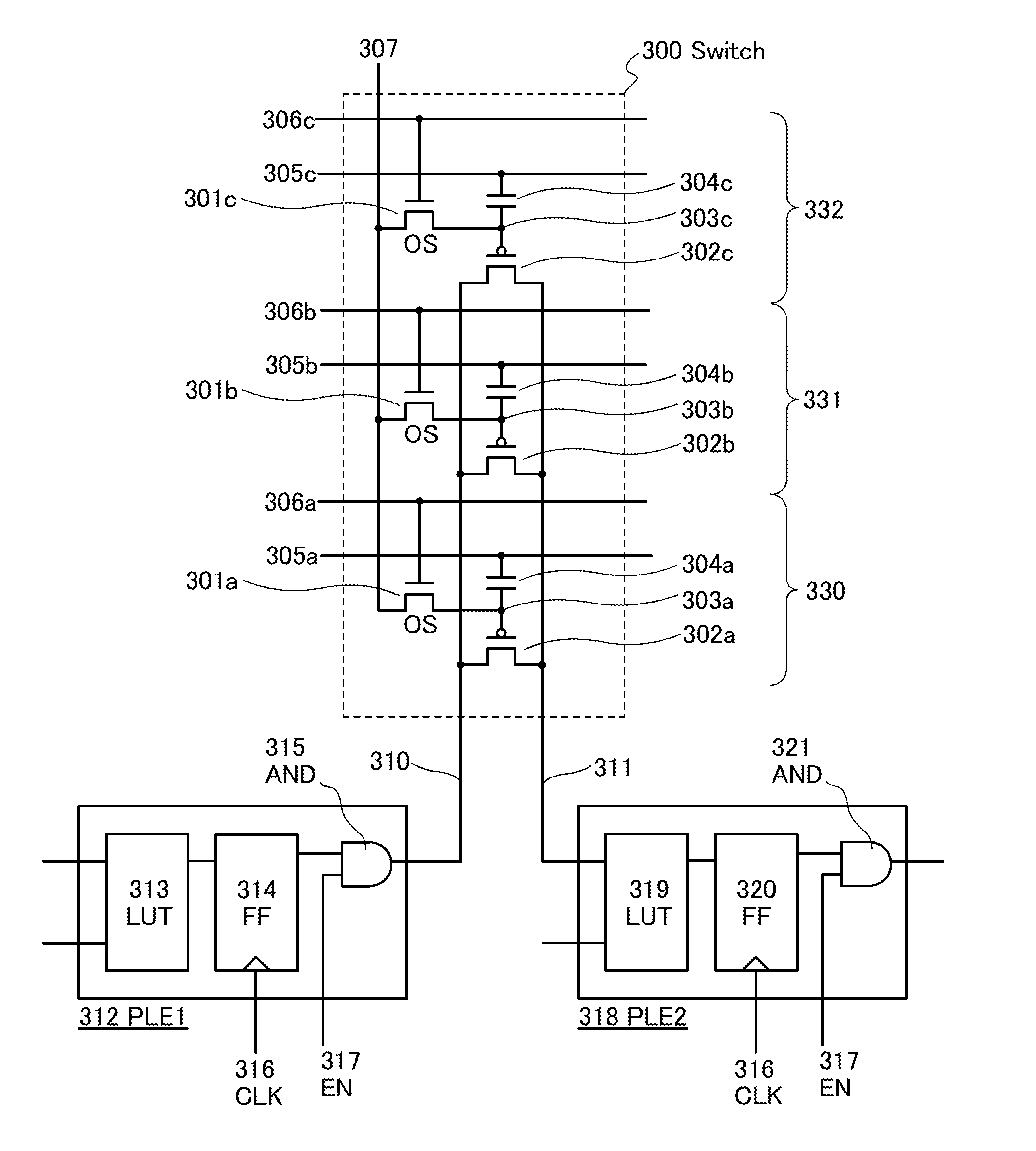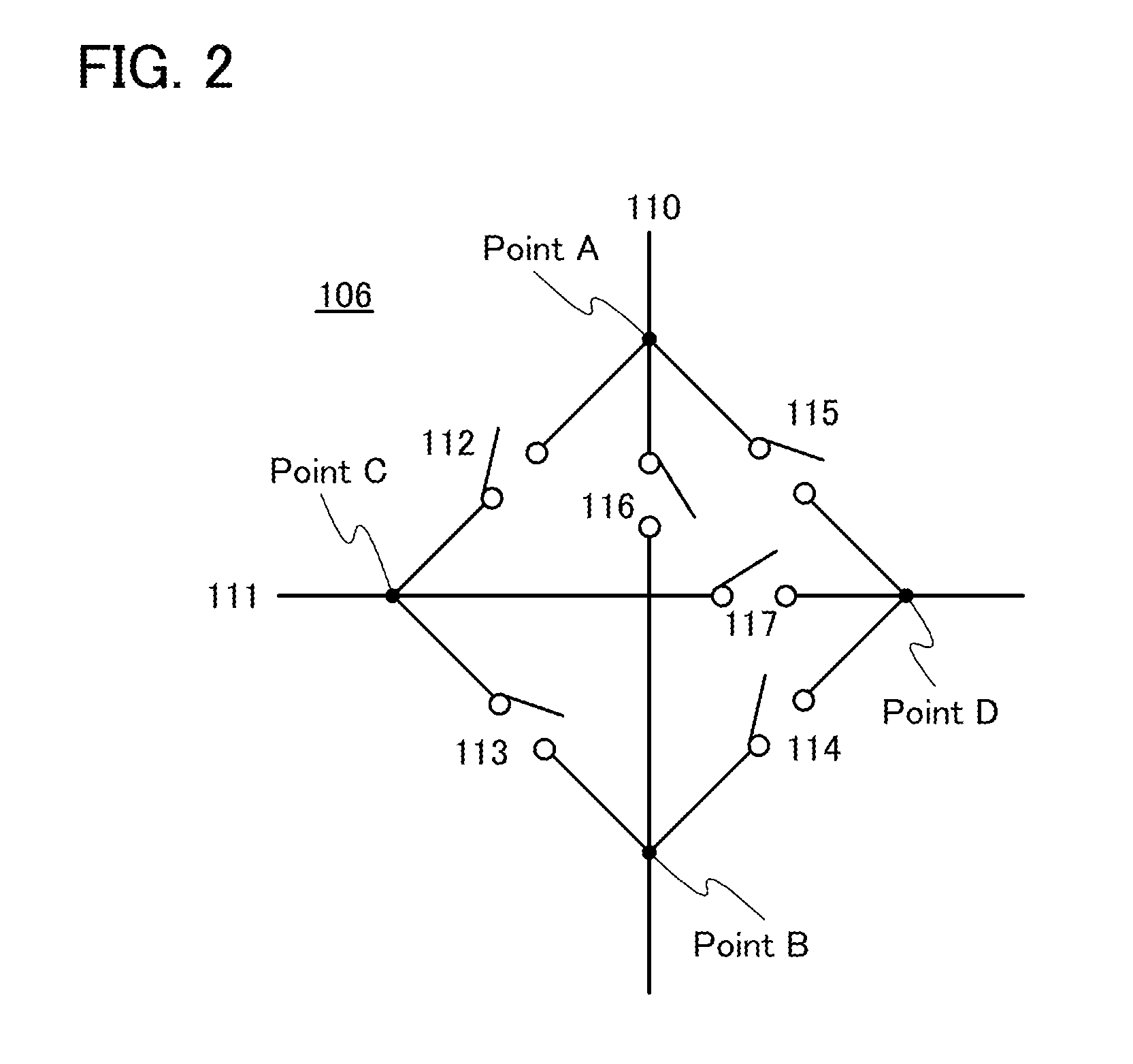Programmable logic device
a logic device and programmable technology, applied in the direction of logic circuits using specific components, power consumption reduction, pulse techniques, etc., can solve the problems of increased power consumption, increased circuit area, and significant increase in the number of elements in the entire pld, and achieve short startup time and low power consumption
- Summary
- Abstract
- Description
- Claims
- Application Information
AI Technical Summary
Benefits of technology
Problems solved by technology
Method used
Image
Examples
embodiment 1
[0045]In Embodiment 1, one embodiment of a PLD will be described with reference to FIGS. 1A and 1B, FIG. 2, FIG. 3, and FIG. 4.
[0046]FIG. 1A conceptually illustrates part of a logic array in the PLD. A logic array 101 includes a plurality of programmable logic elements 102 arranged in an array (the programmable logic element is denoted by PLE in FIG. 1A). Here, the term “arranged in an array” means that the programmable logic elements are arranged at regular intervals, and the arrangement is not limited to that illustrated in FIG. 1A.
[0047]A plurality of wirings are formed to surround the programmable logic elements 102. In FIG. 1A, these wirings consist of a plurality of horizontal wiring groups 103a and a plurality of vertical wiring groups 103b. A wiring group is a bundle of wirings, and for example is a bundle of four wirings as illustrated in FIG. 1A. A switch box 104 is provided at an intersection of the horizontal wiring group 103a and the vertical wiring group 103b. The hori...
embodiment 2
[0082]In Embodiment 2, a switch 300 in which the n-channel second transistors used in the switch 200 shown in Embodiment 1 are replaced with p-channel second transistors will be described with reference to FIG. 5 and FIG. 6.
(Structure of Switch 300)
[0083]FIG. 5 illustrates the switch 300 in this embodiment. The switch 300 corresponds to each of the switches 112 to 117 in FIG. 2 and its structure is the same as that of the switch 200 described in Embodiment 1 except that the n-channel second transistors 202a to 202c are replaced with transistors with opposite polarity, that is, p-channel second transistors 302a to 302c.
[0084]The switch 300 controls connection between a programmable logic element 312 and a programmable logic element 318 in a PLD. Each of the programmable logic elements 312 and 318 corresponds to one of the plurality of programmable logic elements 102 in FIG. 1. For example, in FIG. 5, the programmable logic element 312 can be composed of a lookup table 313, a flip-fl...
embodiment 3
[0112]Embodiment 1 shows the switch 200 using three groups each including a first transistor, a second transistor, and a capacitor, whereas Embodiment 3 will explain a switch 400 including at least three groups (hereinafter referred to as N groups, where N is an integer of 3 or more) of these elements with reference to FIG. 7.
[0113]The switch 400 corresponds to each of the switches 112 to 117 in FIG. 2 and controls connection between a programmable logic element 412 and a programmable logic element 418 in a PLD. Each of the programmable logic elements 412 and 418 corresponds to one of the plurality of programmable logic elements 102 in FIG. 1. For example, in FIG. 7, the programmable logic element 412 can be composed of a lookup table 413, a flip-flop 414, and an AND circuit 415, and the programmable logic element 418 can be composed of a lookup table 419, a flip-flop 420, and an AND circuit 421.
[0114]As in the switch 200 described in Embodiment 1, the first transistor in the switch...
PUM
 Login to View More
Login to View More Abstract
Description
Claims
Application Information
 Login to View More
Login to View More - R&D
- Intellectual Property
- Life Sciences
- Materials
- Tech Scout
- Unparalleled Data Quality
- Higher Quality Content
- 60% Fewer Hallucinations
Browse by: Latest US Patents, China's latest patents, Technical Efficacy Thesaurus, Application Domain, Technology Topic, Popular Technical Reports.
© 2025 PatSnap. All rights reserved.Legal|Privacy policy|Modern Slavery Act Transparency Statement|Sitemap|About US| Contact US: help@patsnap.com



